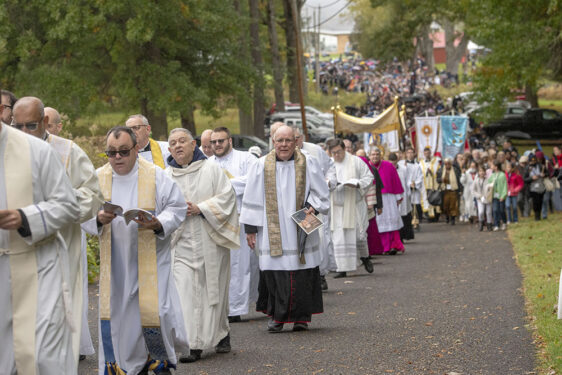
WASHINGTON — Participants who will join the Diocese of Brooklyn’s Eucharistic Revival by subway and then walk together to arrive at the Louis Armstrong Stadium in Flushing Meadows-Corona Park will be linked to an ancient Church tradition.
Since biblical times, believers have joined together or ventured alone to holy sites as a way to deepen their faith. Most often these journeys have been by foot, as the final leg of the April 20 pilgrimage will be when Catholics will join Bishop Robert Brennan from the Mets-Willets Point station to the stadium. Parishioners of three Queens churches also plan to walk to the stadium from their parishes.
“We are really looking forward to it. I think it will help us feel closer to the spirit of the revival to walk as Jesus walked,” Father Manuel de Jesús Rodríguez, pastor of Our Lady of Sorrows Church, told The Tablet.
Bishop Brennan told Currents News April 18 that the significance of the pilgrimage to the stadium is recognizing that there is “something about the journey itself. Basically, life is itself a pilgrimage. We’re walking together with one another and encouraging one another.”
He also said the pilgrimage aspect of the Diocese of Brooklyn’s Eucharistic Revival is “celebrating who we are as Brooklyn and Queens and then we’re celebrating all together who we are as Catholics.”
He noted that the subway’s No. 7 train is so iconic of Queens and part of everyday life, as is Flushing Meadows Park.
As he put it: “One of the things we want to do is connect what we do in Church with real life,” he said.
Those walking to the Louis Armstrong Stadium, and singing or praying en route, represent on a small scale the National Eucharistic Pilgrimage taking place from May 19-July 16. The pilgrims, starting from four different areas in the country, will end at the National Eucharistic Revival in Indianapolis.
The pilgrimage part of National Eucharistic Revival is meant to invite others to join and bring attention to the pilgrims’ destination. “It is a stirring vision — Christ truly present in the Eucharist, traveling across our nation inviting crowds of hungry souls to come and be fed,” said Will Peterson, president and founder of Modern Catholic Pilgrim, a nonprofit group that organizes walking pilgrimages nationwide and partnered with the National Eucharistic Congress to plan the National Eucharistic Pilgrimage.
The idea of pilgrimage is deeply rooted in Church tradition. The Catholic Catechism describes pilgrimages as opportunities for Catholics to strengthen their faith. “Pilgrimages evoke our earthly journey toward heaven and are traditionally very special occasions for renewal in prayer,” it says.
Early Christian pilgrims frequented the Holy Land to walk the footsteps of Jesus, but they also journeyed to famous churches of sites of Marian apparitions.
One particularly famous pilgrimage site is the Cathedral of Santiago de Compostela in Spain.
In a speech there in 2010, Pope Benedict XVI said, “To go on pilgrimage is not simply to visit a place to admire its treasures of nature, art, or history. To go on pilgrimage really means to step out of ourselves in order to encounter God where he has revealed himself, where his grace has shone with particular splendor and produced rich fruits of conversion and holiness among those who believe.”
Put another way, a pilgrimage, whether over a few city blocks or across a country, is a spiritual journey meant to encounter God in a deeper way.
St. Helena, the mother of Emperor Constantine, is often credited for promoting pilgrimages in the fourth century, since she made pilgrimages to the Holy Land and was said to have found the cross that Jesus was crucified on. She also oversaw the recovery of several sacred sites.
In the early Church, people often went on pilgrimage as a form of penance that they chose to do or were told to do to atone for their sin.
In his book, “City of God,” St. Augustine describes the Church as a pilgrim journeying toward a heavenly homeland. He said the miracles associated with certain holy sites provide opportunities for experiencing something tangible about one’s faith.
In other words, the journey is not just a way to physically get from one point to another.
As the National Eucharistic Pilgrimage points out on its website, “a pilgrimage is the simultaneous movement of the feet and the soul — a journey made both externally and internally.”
It adds that the “value of a pilgrimage is not in the distance traveled but in the disposition of our own hearts and the zeal with which we seek God. Many saints have had life-changing experiences while on pilgrimage, and the practice has been a part of Christianity from the beginning.”
